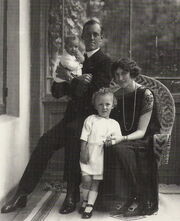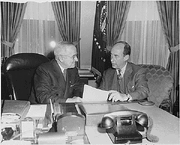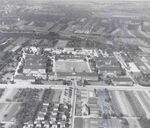| Marged of Wales | |
|---|---|
| 21st Monarch of Wales
| |

| |
| Queen of Wales | |
| Queen of Wales | |
| Reign | 16th August 1950 - 1st July 1959 |
| Coronation | 10th March 1951 |
| Predecessor | Iago |
| Successor | Arthur II |
| Principality of Morgannwg | |
| Reign | 1944 - 16th August 1950 |
| Predecessor | Owain I of Morgannwg |
| Successor | Arthur II of Morgannwg |
| Born | 15 July 1912 Palas Cwm Hyfryd |
| Died | 1 July 1959 Ysbyty Brenhinol Caerdydd (Cardiff Royal Infirmary) |
| Burial | Royal Crypts, Llandaff Cathedral |
| Spouse | Christian Schleswig-Holstein-Sonderburg-Glücksburg |
| Issue | Prince Arthur of Wales
Prince Christian of Wales |
| Full name | |
| Marged Alexandra Catherine Maria Morgannwg | |
| Posthumous name | |
| Marged Gwrolfrydig (the Valiant) | |
| House | House of Morgannwg |
| Father | Iorwerth Cystennin Auguste Pawl Morgannwg |
| Mother | Alexandra Oldenburg |
| Religion | Roman Catholic |
Marged was not born to be queen. Raised as the younger daughter of Iorwerth and married to a Danish Prince, her early life was sheltered and once her brother had assumed the throne she remained very much in the shadows. Following her marriage to Prince Christian she lived in Denmark for three years before returning to Wales to give birth to her first son, Arthur. With the outbreak of war the young family were unable to return to Denmark and as the growing political crisis surrounding Iago grew many politicians began to look to Marged and her sons as alternatives to Iago and his heir Owain. With the death of Owain in 1944 the succession to the Welsh throne fell into doubt. With Iago's rising unpopularity with the Welsh population, and the increase in Republican sentiment it was feared that he would be the last monarch of Wales. In 1947, Iago was forced to name his sister and her sons as his heirs. Chancellor Thomas had been trying to annul the Succession Act which fixed the Welsh succession on the heirs and descendants of Arthur regardless of sex. As of the death of Owain in 1944, the last remaining legal heir to the Welsh throne was Marged's distant cousin, Prince Xavier Dafydd Heinrich Morgannwg (born in Berlin in 1933 and raised in Germany). During the war this was simply unacceptable and would continue to be unacceptable into the post war years. In 1947 Chancellor Thomas succeeded in bullying Iago into putting an Order in Council recognising Marged as his heir and changing the Welsh laws of succession to pure primogeniture regardless of sex.
Early Life
Born on the 15th July 1912 in the Palas Cwm Hyfryd, Marged was largely raised by her mother, Queen Alexandra. With the young death of the her father, Iorwerth in 1920, her brother Iago became king and Marged became, Princess Marged, Kings Sister, a courtly position second only to the new Queen Alice of Wales. The 8 year old princess continued to live with her mother in the Senghenydd Palace in Caerphilly.
On her 18th birthday (1930), Marged entered into the Welsh Court in the Cwm Hyfryd Palace. The shy, nervous young princess was quickly overwhelmed by courtly life. Her distant relationship with her brother the king did not aid her time in Cardiff. Quickly retiring back to the safety of Palas Senghenydd and the Dowager Queen Alexandra she remained there for the next few years. Her mother arranged the marriage of her daughter to Prince Christian, a young son of Christian X, King of Denmark. The marriage necessitated his conversion to Roman Catholicism but this was quickly arranged. Her marriage to Prince Christian occurred on the 20th September 1935 in north Wales (St Asaph's Cathedral). Following the marriage the young couple moved back to Copenhagen to live. When Marged fell pregnant in 1937 the couple returned to Wales, in part due to complications during pregnancy and part to do with the rising tensions in Continental Europe.
The move home proved fortuitous. Prince Arthur was born on the 30th August 1938. The German-Austrian Anschluss had occurred earlier in the year and just days after the birth of the future Welsh king, the Munich Agreement legalised the German annexation of the Sudetenland. With these events, even though Wales at this time was firmly pro-Germany, it was decided that it was safer to remain in Caerdydd.
The Great War
The young family moved to Marged's only real home, the Palas Senghenydd and would remain here during the Great War of 1939-45. Her husband, despite his German name and accent signed up to serve with the Welsh Army. Joining the 1st Royal Dehubarth Dragoon Guards he quickly rose through the ranks, finishing the war as a Cadridog Is-Gapten (Lt General). With her husband serving with the Welsh Army, first in North Africa and later in Northern Europe, the princess was left to raise her young son alone (later a second son, Prince Christian was born during 1941), It was during this time that the princess' smoking habit grew, a habit which would have fatal consequences later on in life.

The family of Marged and Christian 1942
With the outbreak of the war in 1939, Wales was at this point allied with Nazi Germany. With the civil unrest and eventual outbreak of revolt (led by Maeslywyd Thomas) Marged served as a sort of rallying point to those loyal to the crown but not to Iago. Marged was uncomfortable with such distinctions, remaining outwardly loyal to her brother as king throughout the war. With the transfer of executive powers from the Crown to the Office of Chancellor in 1942 and the continued isolation of Iago, Marged and the Palas Senghenydd became the de facto Welsh Court, although her mother, the Queen-Dowager, was its principal head. With the war drawing to a close, the whole Royal Family was thrown into turmoil with the death of the Crown Prince, Owain, during the Normandy Landings. The Crown-Prince, eager to distinguish himself as apart from his father, had volunteered to be amongst the first wave of troops landing and paid the ultimate price.
With the death of the Crown-Prince the entire Royal Family was thrown into turmoil and when news of his death was announced the public support for the various Republican parties in Wales rose ten-fold. With Owain's death under the Succession Laws enacted in the 19th Century, the throne would fall to a German Prince come the death of Iago.
Line of Succession ~ During Iago's Reign
- Owain, Crown-Prince of Wales (1921-1944)
- Dafydd Bren, Prince of Wales & 6th Duke of Harlech (1906-1945)
- Xavier Bren, Prince of Wales & 7th Duke of Harlech (1933-2002)
The main obstacle was the fact that Dafydd, whilst having been born in Wales and being the GGG Great Grandson of Arthur I of Wales, and indeed was in 1944 the last living male line descendant of Arthur, was also married to a German (Helga Bortismund) and was a serving officer in the German Wehrmacht. Lt-Colonel Morgannwg (Oberstleutant Morgannwg) served with the 102st Infantry Division on the eastern front, dying eventually in East Prussia during the Soviet advance on Konisberg. Such a man was patently unsuitable for the Welsh throne at this time and therefore by the same distinction was his infant son, Xavier (who would also serve under German arms during the defence of Berlin).
For the Republican's the answer was simple, abolish the Welsh Monarchy and create a Welsh Republic (Y Weriniaeth Cymreig). For Royalists it meant trying to find a way around the legal blocks on female descendants ascending the throne. A major block to this was Iago himself. He was determined not to allow his sister to succeed to the Welsh Throne and it would take until 1947 before his hand was forced and he signed the Instrument for Change in Welsh Succession which would allow female line descent.
Line of Succession ~ Following Change to Laws of Succession
- Marged, Tywysoges Morgannwg a Chymru / Princess of Glamorgan & Wales
- Arthur, Prince of Wales
- Christian, Prince of Wales
- Heinrich Wittelsbach, Prince of Bavaria & Wales
- Otto Wittelsbach, Prince of Bavaria & Wales
- Alfonso de Borbon y de Braganza, Prince of Spain, Portugal & Wales
- Pedro de Borbon y de Braganza, Prince of Spain, Portugal & Wales
- Miguel de Borbon y de Braganza, Prince of Spain, Portugal & Wales
- Elena de Borbon y de Braganza, Princess of Spain, Portugal & Wales
- Xavier Bren, Prince of Wales & 7th Duke of Harlech
The new law of succession still left the Welsh throne at risk of a German succession, as Heinrich Wittelsbach also served in the Wehrmacht and his son Otto was another youth forced to fight for the Nazis, but at least there was now a buffer with Marged and her sons, and also the possibility of jumping to the descendants of Heledd ferch Cystennin (who also had claims for the Portuguese and Spanish thrones).
Heir to the Throne
The proclamation of 12th October 1947 named Marged as heir to the throne and the days following this her husband, Prince Christian set up Royal Offices for her in both Palas Senghenydd and Palas Cwm Hyfryd. With Iago released from house arrest he was also present in Cwm Hyfryd and this was the first time since the birth of Arthur that the two siblings had been in each others company. During the remainder of 1947 and the beginning of 1948 Marged received many diplomatic visitors including the American ambassador as attempts were made to find out what type of person she was, so reclusive she had been for her adult life.
In June 1948 an attempt was made on her life by activists for the Communist Party. Though the attempt failed it reinforced her desire to remain from the lime-light. During this period it was Prince Christian who behaved very much as the "heir". His war time record and subsequent contacts both with the American and British governments enabled him to act as coordinator for the reign to come.
The elections in late November 1949 returned Rheged ap Seith and the Communist Party as Chancellor and the largest party in the Ty Isaf. With the American forced reforms of early 1950 coupled with an apparent disregard for the monarchy it looked increasingly unlikely that Marged would ever succeed to her brother.
Queen of Wales
On the 16th August 1950 in the midst of general political unrest, civil instability and increasing reliance on an American troop presence to maintain peace, Iago died. In the Senedd, Rheged ap Seith sensed his chance. The elections of November 1949 had returned his party (the Communist Party) as the single largest party in the Lower House. He commanded a small majority aided by the Welsh Labour Party. On the 17th August 1950, just 24 hours after the announcement of Iago's death, Rheged announced the creation of the Peoples Republic of Wales (Gweriniaeth Pobl Cymru) and the creation of the Mawreddog Sofietaidd (Grand Soviet) to replace the Senedd. With orders flying from Caerdydd, the Fyddin-Llynges Sofietaidd (Army-Navy Soviet) and the Llu Awyr Sofietaidd (Air Force Soviet) seized control of the military apparatus, with Comisiynwyr (Commissioners) taking control of the provinces. The Queen and her family were placed under house arrest in Palas Senghenydd, with men from Byddin y Chwyldro (the Revolutionary Guard) serving as gaolers and protection in turn. Organised resistance to the take over from within Wales was weak and disjointed. The war and Iago's role in it had stripped the monarchy of the sympathy of the people. The Soviets were still not viewed as monsters, in spite of the Iron Curtain which had already fallen across Europe. The people were poor and hungry still following the war and Rheged ap Seith offered a return to prosperity without American troops enforcing it.

The 1950 Flag of the People's Republic of Wales
The dream of a People's Republic however would be stillborn. The Prince-Consort Christian returned from America on the 20th August 1950 with the full force of the American President behind him. Truman was not about to allow the Soviet Union to gain a base in Western Europe and he ordered the American troops in Wales to put down the nascent Communist State. Christian headed up the provisional Royalist government in Llwydlo and over the next two months the American Army and Air force re-took control of Wales. During this, Marged made two broadcasts from Palas Senghenydd, the first was whilst the Communist Party was in full control and this speech called on all Welshmen to accept the rule of law and to recognise the legitimate elected government of Rheged ap Seith. The second speech was made after the American's had liberated Caerfilli and this speech called on Welshmen & women to stand up for their democratic rights and to not descend blindly into dictatorship. With the weight of Truman and the American military in addition to the naval blockade by the British Navy the People's Republic was dead and burried by 20th October 1950 with Rheged ap Seith killed

Prince Christian meeting President Truman
whilst fighting American soldiers. The end of the communist uprising was not the end of Marged's ordeals however. The American's were as strongly republican as the communists and with an American General in effective control of Wales a referendum was launched to determine if Wales should become a Republic or not. The results were knife-edged. A Royalist return of 51.6% against a Republic result of 48.4% in the December referendum resulted in a jubilant Prince Christian giving a speech to both Houses of the Senedd, with Marged giving a radio broadcast thanking her subjects for allowing her to serve as Queen.
1950-1955

Entrance to Amwythig Airbase
From the start of her reign, the differences were already apparent between Marged and Iago, and indeed with all of the monarchs of the House of Morgannwg. The war, Iago's part in it and the now huge presence of American troops in Wales all

F-86 Sabre display at Amwythig Airbase
resulted in Wales' first limited monarch. Marged would proceed to have little direct influence on the Welsh political scene. Although her husband, Prince Christian, continued to head the Privy Council on her behalf and held regular meetings both with the Chancellor and with the American General stationed in Wales. President Truman attended the coronation held on the 10th March 1951 and used the occasion to open the five new American bases within the Welsh Kingdom. The two main bases were the Amwythig Air base in north-east Wales and Casgwent (later Truman) Barracks in Gwent. The other three bases were Penally Barracks in west Wales, Roosevelt Barracks in north Wale

Casgwent (later Truman) Barracks in Gwent
s and Sherman Barracks outside Caerodor. The American's also gained the exclusive use of certain piers in Milford Haven Dockyard. Such an overwhelming American military presence in Wales ensured that their man, Thomas ap Tomos Gruffydd became first interim Chancellor and then full Chancellor in quick order. As leader of the Welsh Christian Democratic Party, Thomas ap Tomos was a centre-right politician who's personal political stance leaned towards republicanism but was not nihilistically republican. For two years (1950-52) he ruled as Llwyddo Ganghellor which means "Succeeding Chancellor" and was the Welsh approximation to the old Roman Consular title of "Consul Suffectus". This emergency rule lasted until 1952 when Thomas ap Tomos felt secure enough to hold Senedd elections. During this time the CIA and the Asiantiaeth Diogelwch Cenedlaethol (ADC or the National Security Agency - NSA) which was the successor organistation to the UDC had torn through Welsh politics like a hurricane searching out communist sympathisers. The election itself was a bitter affair. Voter intimidation was rife. The Communist Party's support was largely in the industrial heartlands of the south. Morgannwg, Gwent, Gwyr, Ystrad Towy, Gwlad yr Haf were places where they could expect strong support. The PGC (CDP) was strong across mid Wales, with Ceredigion, Powys, Ty Dewi, Henffordd, Ergyng all returning large numbers of senators. Ap Tomos however had the advance of using the state apparatus to his needs. As such it was unsurprising when Thomas ap Tomos was returned with a large majority in the November elections of 1952. Queen Marged authorised his forming a government.
During these years Wales benefited from massive investment from America. Starting with aid via the Marshall Plan and then massive loans to help prop Wales back up onto her feet.
1953 would prove to be a momentous year personally for Marged. In the February, Maeslywydd and former Chancellor Thomas died. Such was his massive personal popularity within Wales that he was granted burial within St Davids Cathedral. Later on in the year Prince Christian also died. During this year under American supervision, Chancellor Gruffydd also began the de-colonisation process within the Welsh Empire.
With the death of her husband, Marged withdrew from public view for the remainder of the year. Her son, Prince Arthur was not yet old enough to take a more active role within politics and so it fell to Chancellor Gruffydd and the politicians to move into spheres of policy which previously had either been exclusive to the crown or highly influenced by it. The role of President of the Privy Council fell to Prince Owain V of Gwynedd, not known for his support for the House of Morgannwg as both his father and his cousin (Princes Iolo and Owain IV respectively) had died during the Great War with Owain himself serving briefly in 1945 as a 17 year old officer cadet. With a hostile Privy Council president, an openly republican Chancellor, a political unwilling Queen and a still underage heir, it was a dark time for monarchists in Wales.
1955-1959
1955 opened badly for Marged. With the death of her husband in 1953 the Queen had gradually withdrawn more and more from both public life and political life. Until the Great War the Welsh political scene had been dominated by kings who had willingly and regularly interfered in the political sphere. The Welsh constitution in 1955 still only being just over 50 years old. Between 1953 and '55 the prime Royalist political mover was Prince Owain V of Gwynedd. As President of the Privy Council (Llywydd y Cyfrin Gyngor) he was free to operate as the monarchs cypher and with Marged's disinterest in politics that meant Owain's agenda was free to be implemented. As such he often butted heads with Ap Tomos Gruffydd. During 1955 these encounters happened more regularly as they clashed on health care, defence and taxation policy. During the spring of this year Marged was diagnosed with cancer. The shock of the diagnosis and the particular strain of cancer (lung) led to her hospitalisation and an attempted lobectomy to remove the diseased section of lung. The operation did not go according to plan and the Queen was left severely ill as a result.
During her long immobilisation Prince Arthur began to build up an inner council in direct competition to the Cyfrin Gyngor (Privy Council). On his 18th birthday on the 30th August 1956 he made his move. As Tywsog Morgannwg he was already equal in rank to Prince Owain, as the Crown Prince however he outranked the Gwyneddian Prince. The Chancellor also saw this as a chance to remove the thorn of Owain from his political side. As a result, the Senedd (and therefore the American's also) allied themselves to the Crown Prince. An announcement read from the steps of the Senedd building in Caerdydd's city centre proclaimed the Crown Prince as Regent (Tywysog Rhaglaw). As such he automatically assumed the presidency of the Privy Council from the Prince of Gwynedd.
Mutiny of '56
Of more importance to the Chancellor during this time was the growing dissatisfaction within the Welsh military. During the abortive attempt to form a People's Republic one of Rheged ap Seith's greatest success' was the subverting of the Welsh military to the Communist cause. The common serviceman had during the attempted coup been a Great War veteran and had little cause to love the CDP or their cause. Rheged had set up the Peoples Commissary Department during his time in government and so far Thomas ap Tomos had been unable to remove it (it would still exist as a government department into the 21st Century). As such there were still Army, Navy and Air force "Soviets" (Y Fyddin Sofietaidd, Y Llynges Sofietaidd and Yr Awyrlu Sofietaidd). These presented as a united front as the Sofietaidd y Bobl which in turn was part of the Plaid Gomiwnyddol (Communist Party). In late spring of 1956 the Naval Soviet (Llyngesol Sofietaidd) mutinied. Several ships of the Navy joined this mutiny which quickly spread to the docks of Penfro and Aberdaugleddau. The bases and the ships in the docks there became no go areas for the Government. At the same time several army and air force units also mutineed.
The Chancellor panicked. Faced with a serious looking revolt within the Welsh services and the Communist Party (now led by Moriddig ap Madog) was agitating elsewhere in the country. When the barracks at Llwydlo also rose up in revolt however Ap Tomos turned to the American's.
American troops and the American CIA moved in on the areas in revolt. Using heavy handed tactics they crushed the mutiny's within 2 months. By the end of September the military soviets had been defeated. The price that would be asked however was the outlawing of the Communist Party and the active hunting of known sympathisers. This was something to which Ap Tomos readily agreed. The American Ambassador himself presented the demands to Prince Arthur in Cwm Hyfryd Palace. The other major victim of the mutiny was Ap Tomos himself. Faced with close to open revolt within the CDP for his leadership during the crisis he resigned on the 5th October 1956.
1957-1959
These years would be quiet ones within Wales. The election of 1957 returned the CDP to power (although under the leadership of Dafydd Fychan) won comfortably. With the Communist Party illegal the election itself was contested between the Social Democrats, the Catholic Party and the CDP. The SDP was tainted by the Communist Party even though it had little to do with the former, whilst the Catholic Party was seen as a staunchly monarchist party and although Marged held a large degree of public sympathy for her illness, the crown itself was still deeply damaged by Iago's actions. During these years Prince Arthur forged a close working relationship with Chancellor Fychan, a man who was related to the Earls of Gwyr, and therefore more amenable to the desires of the Crown.
The queen in this period remained bed-ridden and held close to no influence on political policy within her kingdom. Her son continued to hold Privy Council meetings within the Palas Senghenydd where his mother lived but she showed little inclination to contribute to them.
Death & Legacy
Marged's death in 1959 was a low key affair. Her long illness and her longer withdrawal from public life ensured that her death was not common knowledge within the kingdom for some days following. She died in Cardiff Infirmary (thereafter called the Cardiff Royal Infirmary) on the 1st July 1959. Her funeral was in contrast to her reign a loud colourful affair as Arthur tried to give his mother a majesty she lacked in life and also to give his reign a start that her's lacked.
Marged's reign itself was a period of tumult for Wales. The end of the war saw Wales bruised and battered. The attempt at forming a People's Republic, the effective American occupation of Wales, the political violence of the mid part of her reign and the attempts at mutiny within her Armed Forces all contributed to a dismal decade both for her and her kingdom.
Later on during her sons reign, Marged became a reformed character. The long suffering daughter of a great king, and sister to a tyrant she was named Gwrolfrydig or Valiant and her reign was re-evaluated to show the great changes wrought during it. The start of decolonisation, the beginnings of the modernisation of the economy, the prevention of a communist takeover, these were all seen in a different light by the end of the 1970's.
As a queen however, Marged can only be seen as a failure. It was a crown she did not want and she treated it as such. Whilst her husband lived he acted in her name and it could be said that see acted through him, but his early death and her subsequent retreat from both public and political life ensured that her direct influence on a legacy to her country was denied her.
| Preceded by: Iago |
Queen of Wales 1950-1959 |
Succeeded by: Arthur II |
| Ancestors of Marged Alexandra Catherine Maria Morgannwg | ||||||||||||||||||||||||||||||||||||||||||||||||||||||||||||||||||||||||||||||||||||||||||||||||||||||||||||||||||||||||||||||||||||||||||||||||||||||||||||||||||||||||||||||||||||||||||||||||||||||||||||||||||||||||||||||||||||||||||||||||||||||||||||||||||||||||||||||||||||||||||||||||||||||||||||||||||||||||||||||||||||||||||||||||||||||||||||||||||||||||||||||||||||||||||||||||||||||||||||||||||||||||||||||||||||||||||||||||||||||||||||||||||||||||||||||||||||||||||||||||||||||||||||||||||||||||||||||||||
|---|---|---|---|---|---|---|---|---|---|---|---|---|---|---|---|---|---|---|---|---|---|---|---|---|---|---|---|---|---|---|---|---|---|---|---|---|---|---|---|---|---|---|---|---|---|---|---|---|---|---|---|---|---|---|---|---|---|---|---|---|---|---|---|---|---|---|---|---|---|---|---|---|---|---|---|---|---|---|---|---|---|---|---|---|---|---|---|---|---|---|---|---|---|---|---|---|---|---|---|---|---|---|---|---|---|---|---|---|---|---|---|---|---|---|---|---|---|---|---|---|---|---|---|---|---|---|---|---|---|---|---|---|---|---|---|---|---|---|---|---|---|---|---|---|---|---|---|---|---|---|---|---|---|---|---|---|---|---|---|---|---|---|---|---|---|---|---|---|---|---|---|---|---|---|---|---|---|---|---|---|---|---|---|---|---|---|---|---|---|---|---|---|---|---|---|---|---|---|---|---|---|---|---|---|---|---|---|---|---|---|---|---|---|---|---|---|---|---|---|---|---|---|---|---|---|---|---|---|---|---|---|---|---|---|---|---|---|---|---|---|---|---|---|---|---|---|---|---|---|---|---|---|---|---|---|---|---|---|---|---|---|---|---|---|---|---|---|---|---|---|---|---|---|---|---|---|---|---|---|---|---|---|---|---|---|---|---|---|---|---|---|---|---|---|---|---|---|---|---|---|---|---|---|---|---|---|---|---|---|---|---|---|---|---|---|---|---|---|---|---|---|---|---|---|---|---|---|---|---|---|---|---|---|---|---|---|---|---|---|---|---|---|---|---|---|---|---|---|---|---|---|---|---|---|---|---|---|---|---|---|---|---|---|---|---|---|---|---|---|---|---|---|---|---|---|---|---|---|---|---|---|---|---|---|---|---|---|---|---|---|---|---|---|---|---|---|---|---|---|---|---|---|---|---|---|---|---|---|---|---|---|---|---|---|---|---|---|---|---|---|---|---|---|---|---|---|---|---|---|---|---|---|---|---|---|---|---|---|---|---|---|---|---|---|---|---|---|---|---|---|---|---|---|---|---|---|---|---|---|---|---|---|---|---|---|---|---|---|---|---|---|---|---|---|---|---|---|---|---|---|---|---|---|---|---|---|---|---|---|---|---|---|---|---|---|---|---|---|---|---|---|---|---|---|---|---|---|---|---|---|---|---|---|---|
|
||||||||||||||||||||||||||||||||||||||||||||||||||||||||||||||||||||||||||||||||||||||||||||||||||||||||||||||||||||||||||||||||||||||||||||||||||||||||||||||||||||||||||||||||||||||||||||||||||||||||||||||||||||||||||||||||||||||||||||||||||||||||||||||||||||||||||||||||||||||||||||||||||||||||||||||||||||||||||||||||||||||||||||||||||||||||||||||||||||||||||||||||||||||||||||||||||||||||||||||||||||||||||||||||||||||||||||||||||||||||||||||||||||||||||||||||||||||||||||||||||||||||||||||||||||||||||||||||||
